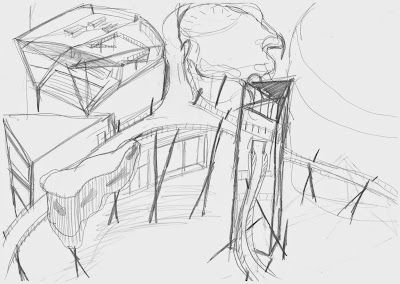Development
Two Concepts:
The two starting concepts of this experiment came from two esteemed architects Hans Scharoun , and Daniel Libeskind. These concepts are respectively: The ideal of 'centripetal and centrifugal,' and 'interwoven forms create layered space'
Axonometrics:
Hans Scharoun - Centripetal and Centrifugal
Daniel Libeskind - Interwoven Forms Create Layered Space
Parallel Projections:
The Electro-liquid Aggregation Process began by combining the aforementioned concepts and their accompanying axonometric drawings into another entity.
Hans Scharoun - Centripetal and Centrifugal
+
Daniel Libeskind - Interwoven Forms Create Layered Space
=
Through the Interwoven forms of the building vivid spaces are created, this notion is parallel to how multicultural environments bring greater richness to the community, reflecting how divergent elements in society eventually resolve towards a single direction.'
This combined design concept, brought the two separate architects concept together, by distinguishing their similarities. These ideals were then applied to the brief taking into account the themes surrounding the Sports Park and the Blacktown Council community, including: technology, sustainability, multiculturalism and the Aboriginal past.
Textures:
Light
Curvilinear and irregular texture, inspired by the forms of nature
Medium
Tile - like pattern texture, utilizing symbols inspired by aboriginal art and culture
Dark
Linear and compact texture, creating an emphasis on darkness, through the contrast of lines against a white background.
Final
The final result was a marker situated near the overlapping of the Eastern road and the West link M7.
The Marker was designed to be situated on top of the hill next to the road. With a proposed park in the adjacent area. In this location the Maker provides a monumental sign indicating that the Blacktown International Sports Park was nearby, it would also serve as a sightseeing platform of the proposed park lands with its elevated position.
5 Images:
The image above is a high angle shot of the Marker along the M7. This shows the Markers relation to the Blacktown International Sports park, and how it will be easliy seen from the road, indicating the location of the sports park. This image also shows the basic form of the structure, with a pivot and a massive weight balancing the viewing platform. The Marker also is reflective of its natural surrounding, with a similar shape to the natural form of a tree.
This is an image taken from the Eastern Road, this image once again shows the monumental size of the Marker, while also demonstrating the dramatic balance of the two main components of the building: the viewing platforms and the main mass of the structure.
Here the immediate site also further reflects the simulation of natural forms by the Marker's overall form.

Here is the main interior space of the marker, during sunset. This image demonstrates the main spaces various features. First of all it shows hows the individual components of the markers main mass all comes together into one interior space. This interwoven nature is further enhanced by the circulation of the room, where it is composed of 4 levels layered within the room and connected by criss - crossing stairs. This image also shows one of the special features of the room, where light from sunrise and sunset can enter from the east and west wings of the building, respectively. Creating a stunning visual effect during certain times of day. Finally the image also shows on the right, one of the three custom textures utilized. Here is the texture designed in a mosaic like pattern composed from aboriginal cultural symbols, while the rest of the room uses a sandstone texture, which reflects Sydney's natural environment. This relationship between the two textures reflects the aboriginal connection to the land, similar to how the forms of the building are connected in this internal space

This image shows the initial exit from the Marker's main interior spaces and out to the viewing platforms. This image reflects the contrast of space utilized to enhance the persons experience of the surrounding environment. As people walk up the stairs and on to the connecting platform, the walls of the main interior space contract to a small square space shown in the image above. This space around people them explodes to infinite, as they leave the building, with the open expanses of the area visible to them, while the exposure from the sun radiates upon them. This dramatization of movement is designed to create an overwhelming feeling, as they walk onto what seems an impossible floating structure lifted above the landscape.

The two images above reflect the interplay of form between the 5 blocks , following Hans Scharouns concept of centripetal and centrifugal. The central beam utilizes one of the custom textures. With a pattern of unidirectional lines, enforcing the central elements importance and linearity, among the other forms, while also symbolically reflecting how Blacktown's future is forwards. This central form supports the 4 other elements, which in relation to the design concept, are reflective of the divergent elements of the community. With the horizontal beams reflective of more natural elements, with its smooth and curvilinear forms, with a natural and irregular texture, inspired by the form of leaves. Contrasted to the vertical beams reflective of the more technological and mechanical elements, with its rectilinear forms, and rigid diagonal cuts into the structure. These contrasting forms although centripetal, all return towards the central beam. Enforcing the design, where divergent elements all resolve towards a single direction.
3D Warehouse upload:
Lumion Files:
Links:






















































